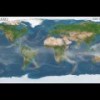Longtime readers will know I like big dye molecules.

Once you get to the size of a phthalocyanine - a little over 1 nm across in any dimension (one of those bonds is about 0.15nm) - weird stuff happens. This explains, in part, G-quadruplexes and liquid crystals,
A friend of mine that made phthalocyanines saw something neat once - you can see them making swirly patterns if you leave a vial containing a solution of them on the bench for awhile, shake it up, it goes away, and it comes back later.
Once you make a molecule about this big (even a little smaller), things get a little weird.
Please share your stories about molecules with >=1nm2 surface area!
More like this
Richard Feyman famously once said that the double-slit experiment done with electrons contains everything t
By Elizabeth Grossman
This weekly posting is brought to you courtesy of H. E. Taylor. Happy reading, I hope you enjoy this week's Global Warming news roundup

Yay for phthalocyanine! It's a pretty green when uncomplexed, and a prettier blue when complexed with many salts. You should post some pictures of it. Here's copper phthaocyanine: http://upload.wikimedia.org/wikipedia/en/c/c3/Copper_Phtalocyanine_Blue…
Copper phthalocyanine, Phthalo Blue, is remarkably insoluble. Try boiling concentrated sulfuric acid or boiling nitrobenzene. Your project: dissolve Phthalo Blue in Plexiglas with no additives and no derivatization or the FDA will make you requalify the "new material" at a cost of ~$50 million. Grinding Phthalo Blue is a fool's errand. By 20 microns the crystal lamellae shuffle like a deck of cards rather than reduce in size.
The solution was a free sample run in equipment otherwise used to make oxide-pinned nickel superalloys. A two-year fully-funded project across three departments required two weeks, $150 of Phthalo Blue and PMMA, and postage. The pound of masterbatch pigment resulting had awesome tinctural power - 10 years worth of stuff to support device manufacture. Uncle Al's reward was... dismissal. They wanted the funding not the product.
Blue ball point pens trigger bittersweet memories. "8^>)